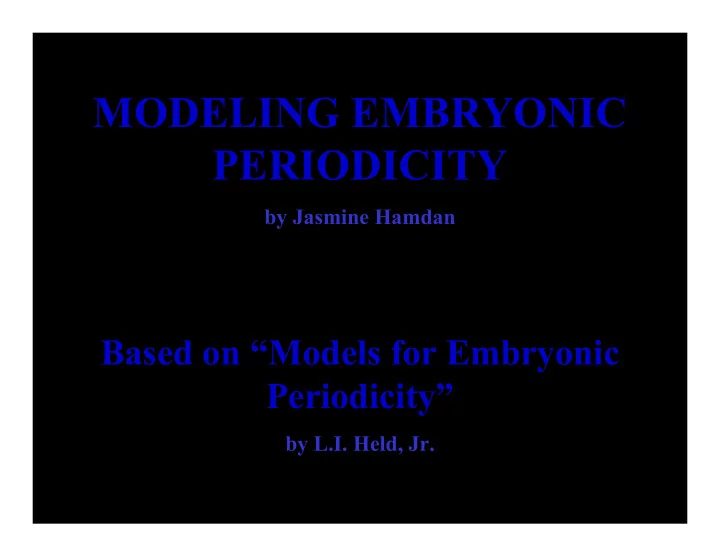

MODELING EMBRYONIC PERIODICITY by Jasmine Hamdan Based on “Models for Embryonic Periodicity” by L.I. Held, Jr.
OUTLINE ÿ Regularity vs. Perdiodicity ÿ Modeling Mechanisms • Positional Information • Rearrangement • Cell lineage
REGULARITY – THE FRENCH FLAG PROBLEM
PERIODICITY – THE AMERICAN FLAG PROBLEM
MODELING MECHANISMS I. Position Dependent Mechanisms (p -> s) II. Rearrangement Mechanisms (s -> p) III. Cell-Lineage Mechanisms (x -> p,s)
POSITION DEPENDENT MECHANISMS (p -> s) ÿ Characteristics • position of cell determines its state ÿ Subclasses • Positional information subclass • Prepattern subclass • Determination wave subclass • Darwinian subclass
Positional Information Subclass ÿ Characteristics • coordinates interpreted as states ÿ Model Types • Gradient Model • Polar Coordinate Model • Progress Zone Model ÿ Example • manifestation of segmentation genes in Drosophila embryos • chick wing development
Gradient Model
Prepattern Subclass ÿ Characteristics • mechanical or chemical signals induce state • cells of adjacent layer induce state ÿ Model Types • Physical Force Model • Reaction Diffusion Model • Induction Model ÿ Example • hair follicles in tiger embryo • bird feathers and mammalian hair
Periodic Buckling
Wave Determination Subclass ÿ Characteristics • traversal of substance determines state ÿ Model Types • Chemical Wave Model • Sequential Induction Model • Clock and Wavefront Model ÿ Example • cAMP in aggregation of slime mold amoeba • wing coloration of flour moth (Ephestia Kuhniella)
Oscillator Model
Darwinian Subclass ÿ Characteristics • selection among competing variants ÿ Model Types • Cell Death Model • State Change Model ÿ Example • rows of lepidoteran wing scales
State Change Model
REARRANGEMENT MECHANISMS (s -> p) ÿ Characteristics • state determines cell position ÿ Model Types • Adhesion Model • Repulsion Model • Interdigitation Model • Chemotaxis Model ÿ Example • somata of motorneurons in zebra fish • photoreceptors in the Drosophila embryo
Interdigitation
CELL-LINEAGE MECHANISMS (x -> p,s) ÿ Characteristics • cell division determines both position and state ÿ Model Types • Quantal Mitosis Model • Stem Cell Model • Cortical Inheritance Model ÿ Example • leech and earthworm embryos • cilia in protistans
Stem Cell Model
“Something of the use and beauty of mathematics I think I am able to understand. I know that in the study of material things number, order, and position are the threefold clue to exact knowledge: and that these three, in the mathematician’s hands, furnish the first outlines for a sketch of the Universe.” - D’arcy Thompson - On Growth and Form
Recommend
More recommend